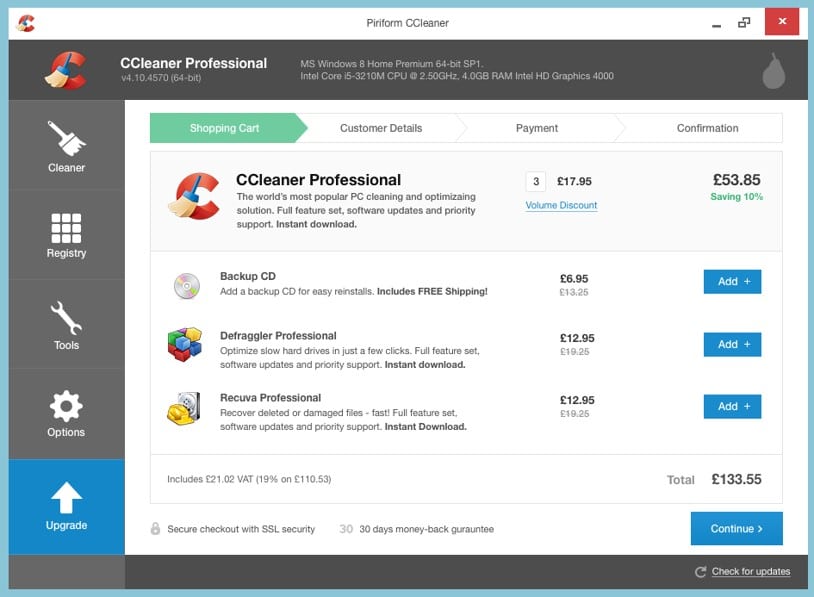Online merchants and ecommerce managers are always looking out for conversion optimization tactics. At a recent cleverbridge Networking Event, Fabian Rothe, business solutions manager at cleverbridge, illustrated three such opportunities. His suggestions require merchants to remove certain barriers to conversion which create ways for increasing revenue. Ultimately, this path to ecommerce success is driven by improving the customer experience.
While transactions are the linchpins of any business, there are many steps for a customer to complete before they are ready to submit payment. Merchants don’t need to make their job (or the customer’s shopping experience) harder than it needs to be.
In general, there are three barriers that typically cause customers to refrain from purchasing your product.
- Customers are required to create an account
- Customers are presented with too much complexity in the shopping cart
- Merchants try to convert free users through an external site
…
Barrier One: Account Creations
Entering a brick-and-mortar store is like entering the homepage of an ecommerce website. Customers browse around the site, they see each section of the store focuses on different products, and assuming all goes well, they proceed to the checkout and pay for the product.
Yet, if one thinks about the checkout process in a retail store, how often are customers asked, “Excuse me, before we are willing to take your money we have a question: Are you a member here?” While it is not unheard of for retail clerks to ask shoppers to join a rewards program and create a store account at checkout, it is also easy for customers to just say, “No, thank you,” and continue with their payment.
When merchants make customers create an account after they have selected a product (but before they have submitted payment) they are creating a major barrier to conversion. Is it really not possible for merchants to take post-transaction data, create the account for the customer and inform them via email, “Hey! Guess what? Now that you’ve bought our product, we have conveniently set up a place for you to manage all your information with our company.” All this without the customer having to expend any effort whatsoever beyond buying the product.
The alternative situation is where merchants require customers to create accounts or log-in prior to submitting payment for a product in which they have expressed interest. In short, this is a really good way to create dissatisfied customers and lower conversion rates and revenue.
Although there are many benefits to both merchants and customers when customers create accounts, the challenge is creating an efficient process for doing so. Don’t encourage customers to find a company with similar products with similar prices who don’t make the buying process enormously burdensome.
Barrier Two: Complexity in the Cart
Returning to the comparison between brick-and-mortar retail versus online B2C ecommerce, a website’s ability to offer customers highly personalized shopping experiences is overwhelmingly greater than a brick-and-mortar store’s ability to do so.
According to Rothe, online shopping is much better at driving revenue than retail because it is quite easy to automate: discounts, volume discounts, cross-sells, up-sells, different currencies, different payment methods and special upgrade offers. So, if a customer shops at a brick-and-mortar store in Japan, it is unlikely that they could ask the merchant to allow them to pay in U.S. dollars instead of yen, or provide the customer with discounts on bulk purchases. Nevertheless, just because one can offer customers special features in the online cart, it doesn’t mean they should.
Consider the following cart:
Overly complex shopping cart
There are 33 different options for a customer to choose from, ranging from currency to cross-sells. As Dan Ariely, an expert in behavioral economics, notes, the more choices you offer consumers the less likely they are to purchase. Instead of making customers make more and more decisions (a surefire way to reduce conversions), simplify their purchase decision by removing options à la the following cart:

Simplified shopping cart
Barrier Three: Free Users
Freemium products and free trials are excellent marketing tactics that help users understand the benefits of products, and creates a positive buzz around brands. But how does one convert those free users into paying customers? Is it better to leave the decision entirely in the users’ hands? That means relying on customers to exit the application, open their browser, search for the company’s site, click through pages until they find the buy button, enter the checkout process, submit payment and then manually activate the program with a license key.
They best way to convert free users and drive more revenue is to keep the checkout process and shopping cart completely in-app. This focuses the customer’s attention on using the product instead of the ordering process, and reduces customer contacts related to ordering and activating the product.
 In-app ordering process (Piriform)
In-app ordering process (Piriform)
According to Rothe, many companies that offer free versions of their products along with in-app purchasing tend to see a majority of transactions occur through that in-app purchasing, and only a small minority convert through the external webpage. Nevertheless, there are companies that see lower conversions for in-app purchases than for external carts.
Free users tend to click on buy buttons more often when a company offers in-app purchasing than when casual customers merely browse the company’s website. In effect, the in-app purchasing process brings in massive amounts of traffic to the cart compared to the website. So when in-app conversion rates appear lower than website traffic, make sure to compare overall transactions and revenue between the two different channels.
Elan Sherbill is a corporate blogger at cleverbridge. You can connect with him on Twitter, LinkedIn and Google+.
